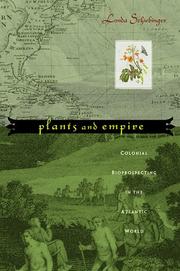| Listing 1 - 1 of 1 |
Sort by
|

ISBN: 0674043278 9780674043275 0674014871 9780674014879 0674025687 9780674025684 0674267095 Year: 2021 Publisher: Cambridge, MA
Abstract | Keywords | Export | Availability | Bookmark
 Loading...
Loading...Choose an application
- Reference Manager
- EndNote
- RefWorks (Direct export to RefWorks)
Plants seldom figure in the grand narratives of war, peace, or even everyday life yet they are often at the center of high intrigue. In the eighteenth century, epic scientific voyages were sponsored by European imperial powers to explore the natural riches of the New World, and uncover the botanical secrets of its people. Bioprospectors brought back medicines, luxuries, and staples for their king and country. Risking their lives to discover exotic plants, these daredevil explorers joined with their sponsors to create a global culture of botany. But some secrets were unearthed only to be lost again. In this moving account of the abuses of indigenous Caribbean people and African slaves, Schiebinger describes how slave women brewed the "peacock flower" into an abortifacient, to ensure that they would bear no children into oppression. Yet, impeded by trade winds of prevailing opinion, knowledge of West Indian abortifacients never flowed into Europe. A rich history of discovery and loss, Plants and Empire explores the movement, triumph, and extinction of knowledge in the course of encounters between Europeans and the Caribbean populations.
Pride-of-Barbados (Plant) --- Herbal abortifacients --- Slavery --- Abortifacients --- Herbs --- Barbados flower-fence (Plant) --- Barbados pride (Plant) --- Caesalpinia pulcherrima --- Dwarf poinciana --- Flamboyant tree --- Flower-fence, Barbados (Plant) --- Flowerfence (Plant) --- Krere-krere --- Paradise flower --- Poinciana bijuga --- Poinciana pulcherrima --- Red bird of paradise (Plant) --- Peacock flower --- Tabachin --- Tabaquin --- Caesalpinia --- History. --- Therapeutic use --- Medicine --- History
| Listing 1 - 1 of 1 |
Sort by
|

 Search
Search Feedback
Feedback About UniCat
About UniCat  Help
Help News
News